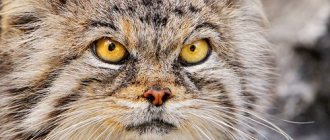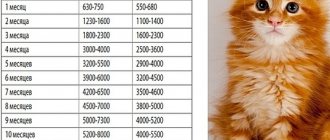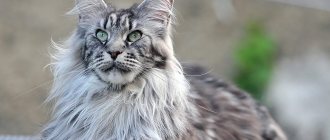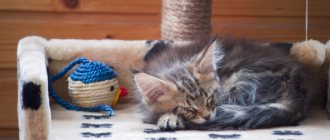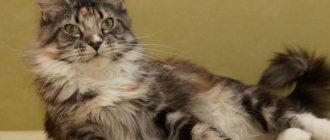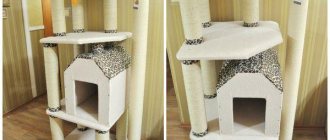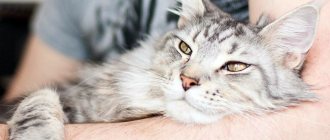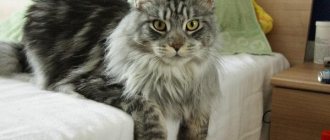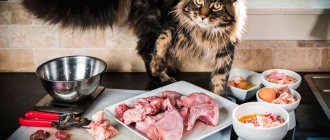Maine Coons are real beauties. Long fluffy tails reaching half the length of the body, lush “whiskers” and a collar, giving the animal a majestic appearance, as well as lynx tassels on the ears have contributed to numerous rumors about the origin of the breed.
The breed standard was recognized at the end of the 19th century. At first, only one Maine Coon color was allowed - black tabby. But over time, these parameters were expanded; today all colors and shades are allowed. The only obligatory condition: cats must have a characteristic mark in the shape of the letter “M” on their heads.
Coons are often called tame bobcats or cat raccoons. There is indeed an external resemblance to wild predators, but all assumptions about the appearance of the breed by crossing a domestic cat with a lynx, jungle cat or raccoon are unfounded.
The homeland of Maine Coons is North America. Here these cats were highly prized by farmers for their hunting skills. It is thanks to landowners that the breed has retained its impressive dimensions. Anyone who has ever seen how big rats are when they plunder barns will understand why it was so necessary to breed a large cat.
Misconceptions about the size of Maine Coons are associated with the impressive appearance of the pets. But, like all cats, Maine Coons are graceful, and their massive appearance is the result of a wide shoulder girdle, an elongated body (reaching 1 meter), large paws, neck and head, as well as a lush fur coat.
Important: The myth about Maine Coons, which claims that cats of this breed reach a weight of 20 or even 30 kilograms, is unfounded. In fact, not a single cat exhibition has recorded a cat weighing over 10 kilograms. Only animals with signs of obesity crossed the 9.5 kilogram mark. The average weight of males is 8 kilograms, and females are 7.
Birth weight
Maine Coons are the largest domestic cats in the world.
Their kittens at the time of birth weigh on average about 115-120 g. Girls are born smaller - 85-145 g, boys - 100-170 g.
Maine Coons are the largest domestic cats in the world
It has been observed that large newborn Maine Coons grow faster than their smaller counterparts.
Factors influencing development and growth
The weight and height of an American handsome man are determined not only by gender and physical condition of the body. Weight and proportions depend on genetic characteristics, the number of individuals in the litter, and the living conditions of the animal.
How a Maine Coon cat’s weight will grow is even determined by the physical and mental state of the pregnant mother cat and the stress that affects her.
The overall development of the body and body size of the Maine Coon are determined by genetic and external factors. The first category includes the following parameters:
- Breed characteristics. The American favorite is strikingly different from an ordinary cat; its appearance is more like a wild forest cat or a small lynx. Moreover, the size of the body of representatives of the breed is directly dependent on the weight category: the more massive the animal, the more actively it grows.
- Gender. A Maine Coon boy gains weight and develops noticeably faster than a girl. The standard difference is about 2 kg.
- The well-being and condition of the mother cat’s body. If she was healthy during pregnancy, felt well, and did not encounter stress, then her cubs will develop quickly and fully.
- Genetic characteristics obtained from the male father. Individuals born from a large and massive sire will also be thicker and more developed.
External factors that determine the body size of a Maine Coon cat:
- Stressful influences. Hormones that negatively affect development are released into the blood of an animal in a state of fear or irritation.
- Food quality. The weight of kittens increases faster if at the initial stage of their existence they suck the milk of a well-nourished mother, and at an older age they receive high-quality and balanced food.
- Living conditions. Maine Coon pets actively gain muscle mass if they live in comfort and are well looked after.
Maine Coon weight by month
The development of young Maine Coons is divided into the following periods:
- neonatal – from the 1st to the 4th day of life;
- suckling – from the 4th day of life to 4 weeks;
- transitional – fifth to eighth weeks of life;
- post-suction – from 2 months until the end of growth.
They grow actively until one year of age, then growth slows down. By one year, an adult cat can weigh 8-9 kilograms.
Maine Coon weight by month is presented in the table:
| Age (in months) | Male weight (in grams) | Female weight (in grams) |
| 1 Week | 200- 250 | 190-220 |
| 1 | 650-700 | 550-600 |
| 2 | 1400 | 1100-1400 |
| 3 | 2300-2500 | 1900 |
| 4 | 3400 | 2700 |
| 5 | 4500 | 3500 |
| 6 | 5200 | 4100 |
| 8 | 6000 | 4700 |
| 9 | 6500 | 5200 |
| 10 | 6900 | 5300 |
| 11 | 7600 | 5700 |
| 12 | 8000-8500 | 6000 |
| 24 | 10000 | 7500 |
| 30 | 12000 | 8000 |
Care
A three-month-old kitten must have the necessary “dowry”:
- bowls for water and food;
- couch, house;
- carrying;
- scratching post;
- tray and filler;
- toys - mice, balls, rubber bands.
It is important for the owner to consider the following:
- The best dishes for kittens are ceramic and earthenware. Such a bowl is difficult to turn over and move. Furry animals are often allergic to plastic.
- Bowls are placed on a tray - this makes it easier to keep the cat’s “table” clean. One container should contain fresh water around the clock, and the other should contain food.
- Three-month-old Maine Coons already go to the litter box without any problems and use litter. But in order for the kitten to get used to the toilet, the baby is “introduced” to it - they are shown several times, the “little kitten” is placed on the tray. It is best to choose a quiet, secluded place where the cat can do its “business” without rushing or getting nervous.
- The bed is also placed in a place where the kitten will not be disturbed by anything. It is best not to move the basket - cats get used to sleeping in a certain location.
- The baby must have a scratching post - strong, securely fixed. It is best to install it on a door or wall so that the cat, stretching out to its full height, can sharpen its claws.
- Caring owners buy playgrounds for their Maine Coons, complexes - tunnels, hanging bridges, “vines” for climbing, “minks”, trunks for claw points. You can make the complex yourself from scrap materials. Such a gift for “Kunenka” will save upholstered furniture, doors and cabinets from attacks.
Maine Coons are the largest representatives of domestic cats. Therefore, even with a 3-month-old kitten, we must not forget about the safety rules:
Do not leave small children under the “supervision” of a cat
A child may inadvertently hit an animal or pull its ear or tail. A cat defending itself can cause serious injury.
Therefore, children are necessarily taught how to behave with such a harsh beast. Maine Coons are very active and curious. Therefore, they close off rooms where animals should not be, balconies, and cover the windows with a reliable mosquito net. They hide sharp, piercing objects, wires, electrical and heating devices, and valuables. “Kunenok” may be interested in indoor flowers from a gastronomic point of view. Therefore, it is worth hiding poisonous plants from him - these are violet, rhododendron, ivy, wisteria, dracaena, azalea, sweet pea, belladonna, alpine violet, mistletoe, orange tree. Maine Coons get along well with other animals - especially if they were taken into the house at the same time as small ones. But don't forget that cats are predators. Therefore, communication with other pets always takes place under the control of the owner.
Direct cat care includes the following:
- Combing wool. Daily procedure: first the owner uses a pattern with sparse teeth, then with frequent ones. Finally, the wool is brushed with a natural bristle brush.
- Trim nails only to the blood vessels. The procedure is mandatory - “coons” have large “combat” claws.
- Cleaning your ears with a cotton pad or swab at least once a week.
- Teeth cleaning. The procedure is important for animals that eat soft food.
- Eye cleaning. The crusts are removed with a cotton pad soaked in cool boiled water.
- Bathing only when necessary - when the coat is dirty or greasy. Use a special hypoallergenic cat shampoo.
At three months, kittens are re-vaccinated. The veterinarian offers vaccinations “Quadriquet”, “Tricket”, “Rabiez”. Before the procedure, deworming is necessary - the drugs Drontal, Milbemax, Kanikvantel are used. For preventive purposes, deworming is repeated every 3 months.
Health of raccoon kittens
Maine Coon cats have enviable health.
The breed was formed in the harsh conditions of the American state of Maine as a result of natural selection, where only the strongest and hardiest animals survived.
Be sure to read:
What to feed a Maine Coon correctly: an adult cat, a kitten or a female cat
To maintain the health of a small pet, it is only important to follow the rules of keeping and carefully monitor its condition.
Key aspects of care:
- good nutrition;
- timely vaccination;
- antiparasitic treatment;
- regular bathing, brushing teeth and ears;
- combing wool.
Diseases
Maine Coon cats are prone to the following diseases:
- Pathologies of the cardiovascular system and joint diseases. A common cause of their development is overfeeding of pets, leading to obesity.
- Inflammation of the gums.
- Liver diseases.
- Ophthalmological diseases: blepharitis, conjunctivitis, keratitis.
- Urolithiasis disease.
- Development of inguinal tumor (in females).
At the first symptoms of any disease, you should immediately seek veterinary help.
Maine Coon cats have enviable health
Vaccinations
For preventive purposes, all Maine Coons must receive their first vaccination at 2.5 months. Subsequent vaccinations occur once a year. These are mandatory procedures.
A few days before vaccination, it is recommended to cleanse the intestines of parasites.
Teeth
Adult cats have very sharp and large teeth. Milk teeth begin to grow in kittens in the second week of their life; at three months of age, their number is 26.
At the age of 3-4 months, the teeth of young Maine Coons begin to change. The front incisors erupt first, followed by the sharp canines. Molars and analogues of “wisdom teeth” grow next.
The process of forming a full set of permanent teeth (adults have 30) lasts up to seven months. During this time, it is important to monitor the development of proper bite.
To prevent Maine Coons from gnawing foreign objects, you need to purchase rubber toys for them.
For the proper development of permanent teeth, it is important to feed cats food with a high content of calcium and phosphorus.
How does the size of a cat and a cat differ?
Maine Coon cats develop more slowly compared to males, and their maximum weight at full development does not exceed 7.3-7.5 kg . Males, which are representatives of the Maine coon cat, are noticeably larger than cats, and the average body weight of an adult neutered animal reaches 12-13 kg.
However, when observing the growth and development of such a pet, it is necessary to take into account the fact that a cat at the age of two cannot weigh more than 10 kg. Such excess body weight may indicate metabolic disorders, heart problems or joint pathologies, so it is necessary to consult a veterinarian. Despite their impressive size, Maine Coon cats do not have problems with obesity at all.
Nutrition
When purchasing a small Maine Coon, it is better to feed him his usual food for a while. Then you can introduce the kitten to other foods.
A complete diet for a small Maine Coon should contain up to 40% protein, 15-30% fat, 2.5% fiber, and the rest should be carbohydrates.
When feeding kittens, it is important to follow a diet. The main diet is raw lean meat. These are beef, chicken, rabbit, and offal. To strengthen joints, you need chicken scallops, beef tendons, and pig ears. Meat should be frozen for at least three days.
The source of minerals will be raw chicken necks, heads, backs, paws, and tails. They must be ground or given whole. Raw yolk is very useful for kittens.
Be sure to read:
Caring for an amazing raccoon cat - Maine Coon
When purchasing a small Maine Coon, it is better to feed him his usual food for a while
Fish should be given with caution and infrequently. Kittens drink milk for up to two months, and then their body loses the ability to digest lactose. It is replaced with fermented milk products, cottage cheese, and hard cheese.
Sometimes kittens happily eat raw grated vegetables and fruits and herbs. Adding a small amount of olive oil will help. There must be clean water available at all times.
It is not recommended to feed kittens food from the human table: it contains too many different additives that are harmful to the animal’s digestion.
Natural nutrition table for Maine Coon kittens by month
The nutritional norms and diet for Maine Coon kittens are presented in the table:
| Age in months | Daily value in grams | Number of feedings per day | Diet |
| Up to a month | Around the clock | Mother cat's milk | |
| 1,5-2 | 150-190 | 6 | Milk, liquid porridge, pureed meat |
| 2-3 | 180-240 | 4 | Raw lean meat, liver, some sea fish, vegetables, fruits, egg yolk, kefir, yogurt, a little olive oil. |
| 3-6 | 180-220 | 4 | Offal, chicken feet, heads, backs are added |
| 6-9 | 200-250 | 3 | Same diet |
| 10-12 | 180-220 | 2 | Same diet |
Feeding kittens with prepared food
High-quality industrial cat food contains all the necessary nutrients. Some manufacturers produce special food for Maine Coons: Bosch Sanabel Kitten, Royal Canin, Hills.
The amount of dry food is calculated individually and depends on the size of the kitten. First, the granules should be diluted with store-bought milk. Adults can be given canned food.
Industrial feeds are stored for a long time and are convenient to use. The packages usually indicate the serving size and other recommendations.
How much should a kitten weigh at different stages?
During the first 15-20 days of life, kittens spend a lot of time sleeping.
After about 16 days from the moment of birth, babies begin to be interested in things happening around them, and by the age of 1-1.5 months they can be safely released from the box so that inquisitive animals begin to explore the world on their own.
During the first six months of life, the kitten gains weight up to 3 kg. Kittens must be weighed every day. If the kitten weighs less than 80 g, it is weighed up to 2 times a day.
You should pay attention if there were more than 5 kittens in the litter. After all, it is in this case that kittens may weigh less than normal; there is not enough mother’s milk for everyone.
It is advisable to carry out weighings at the same time to obtain reliable results. Without this, it will be unclear how much additional power is needed.
Overfeeding kittens is harmful to health. When weighing, it is necessary that the mother of the kittens be nearby and see what is happening with her children. Animal stress can have a negative impact on the quality of milk produced, and as a result, on the condition of the kittens themselves.
What to do if the kitten is not gaining weight?
If the kitten begins to noticeably lag behind its brothers and sisters in size and stops gaining weight, then it should be monitored.
The reasons for the lag may be the following:
- disease;
- stress, especially when changing the usual environment, which soon passes;
- The baby can be eaten by larger kittens.
Be sure to read:
Polydactyly (hyperdactyly) in cats: polydactyly, broad feet, many fingers, what kind of deviation?
If the cub is not gaining weight, but looks quite healthy and cheerful, then it may be necessary to change its diet to something more nutritious.
When you need veterinary help
Typically, difficulties arise when a Maine Coon cat gives birth for the first time, and newborns are born with difficulty. You need to call a veterinarian for help if:
- The contractions lasted more than 2 hours, but not a single baby appeared.
- Heavy bleeding began immediately or after childbirth.
- Mom’s temperature dropped below 37 degrees or rose above 40.
- The fetus remains in the birth canal without movement for more than 10 minutes.
The first birth of a Maine Coon is an exciting event, but you should not worry more than necessary. On the contrary, you should study all the necessary information and be ready to provide qualified assistance to your cat. This will allow the owner to react correctly if something goes wrong.
I like1I don't like
